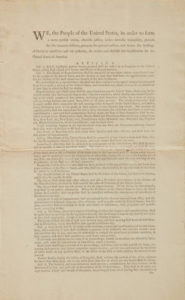The Crypto-Constitution-Catastrophe… does anyone know how any of this works?
Crypto-mania is still going strong and the jealousy-inducing headlines keep coming… but as evidence that many of us still have no idea how it all works, I present the following mess (I’ll preface this with – there are a lot of strange terms, so I hope I don’t lose you):
Last week, a group of “investors” pooled their resources… I used quotes as the term investor is being used loosely in this case. In the crypto world, there is something called a DAO or Decentralized Autonomous Organization – essentially they are like social clubs online, and in some cases each member contributes money to make a purchase collectively.
In this instance, the ConstitutionDAO (I haven’t been able to find how many members there are) set out to raise money to buy a copy of the Constitution that was up for sale at Sotheby’s. In a shockingly short amount of time, the ConstitutionDAO had 11,000 Eth contributed towards the effort – approximately $45 million!
From the beginning, it was made clear that those who contributed would not earn a fractional ownership, but would be given tokens which allowed the group to vote on what would happen with the copy of the Constitution after it was purchased – the tokens were called $PEOPLE, and each Eth donated would be compensated with 1 million $PEOPLE (Trust me, I know it’s getting weird and it gets worse).
Now fast forward to the auction… $45 million should have been enough to secure the auction win, until it wasn’t. That’s when the madness began to unfold… one issue which was seemingly not considered: is in the event they were unsuccessful, how would funds be returned? Well, a real world crypto lesson is that there are something called “gas fees” and when you interact with the blockchain, you are charged those fees… and if you made a small donation, the fees to return the money may be more than the original donation. Simply put, it was more expensive to get your money back than to take the loss… remember, we’re talking a collective $45 million.
To make matters worse, the group never formally structured the voting system for the $PEOPLE tokens they distributed, and after they lost the auction it was announced that the group leaders were developing a new token. So, each person who contributed was left with some amount of a worthless digital currency. As you could imagine, a lot of people were angry… and in response, the group scrapped the new token and reverted back to the original plan of returning funds. So to be clear, the $PEOPLE token went from a volatile speculation, to totally worthless, then back to possibly valuable within 24-hours.
The part that makes it all the more ridiculous is a DAO is supposed to be completely democratic and transparent, but without a voting system in place it continues to be governed by a small anonymous group… which brings me back to my original question of – does anyone know how any of this works?
In case you are wondering, the winning bidder was Citadel’s Kenneth Griffin. He will be loaning it to Crystal Bridges Museum of American Art in Bentonville, Ark.

